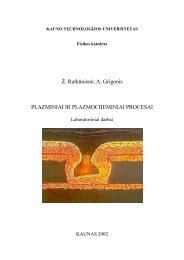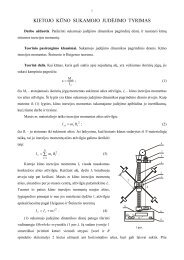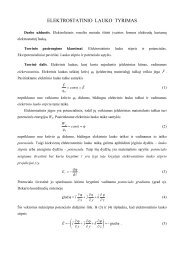PROCEEDINGS OF THE 7 INTERNATIONAL ... - Fizika
PROCEEDINGS OF THE 7 INTERNATIONAL ... - Fizika
PROCEEDINGS OF THE 7 INTERNATIONAL ... - Fizika
You also want an ePaper? Increase the reach of your titles
YUMPU automatically turns print PDFs into web optimized ePapers that Google loves.
Measurement<br />
points<br />
S. Plaude et al. / Medical Physics in the Baltic States 7 (2009) 52 - 55<br />
Fig.1. Test field configuration.<br />
2.2. Test field configuration<br />
Intensity modulated test field is made so that 10 cm<br />
width symmetrical to the CAX the dose is high and<br />
uniform, but 5-7 cm from the CAX there is low dose<br />
region (Fig.1.).<br />
A desired fluency was obtained using dynamic MLC. In<br />
the middle part of the test field a speed of leaves is 0,4<br />
cm/s, but at the edge of the field MLC leaves move at<br />
2,0 cm/s. A gap between opposite leaves is 3 mm.<br />
Measured points were chosen so that they cover the<br />
high dose region as well as low dose region. Dose was<br />
measured in 10 points with 1 mm interval between<br />
them. There is a high dose gradient between two dose<br />
levels.<br />
2.3. Ionization chambers<br />
Three radiation detectors were used. PTW 30006<br />
“Farmer” type chamber with its active volume 0.6 cm 3 ;<br />
PTW 31002 “Semiflex” type IC 0.125 cm 3 ;<br />
Scanditronix Wellöfer semiconductor p-type diode<br />
model PFD 3G (Fig.2.). Diameter of active area of the<br />
detectors was 6.1 mm, 5.5 mm and 2.0 mm respectively<br />
[7].<br />
Detectors were positioned with their longitudinal axis<br />
perpendicular to the beam axis. Measurements were<br />
made in a depth of 5 cm with SSD (Source – Skin<br />
Distance) =95 cm and SAD (Source – Axis Distance)<br />
=100cm.<br />
Dose profiles for dynamic field were acquired using<br />
film dosimetry. Films were irradiated in water<br />
equivalent phantom at a depth of 5 cm at the isocenter<br />
plane. Kodak ® X-Omat films were used for the<br />
measurements.<br />
2.4. Dose modeling<br />
CAX<br />
A simple model using Microsoft Excel software was<br />
developed to calculate the integrated dose in arbitrary<br />
units inside volume of IC. Employed model was using<br />
chamber volume as only parameter to model chamber<br />
response to the photon fluency delivered by means of<br />
moving leaf gap. This model allows to estimate the<br />
response of the IC depending of the velocity of MLC<br />
leaves and the gap between opposite leaves. It was also<br />
possible to take into account a diameter of IC cross-<br />
53<br />
section, which is the main parameter of our interest.<br />
a)<br />
b)<br />
c)<br />
Fig.2. Radiation detectors: a) PTW 30006 “Farmer”; b) PTW<br />
31002 “Semiflex”; Scanditronix Wellöfer semiconductor ptype<br />
diode<br />
3. Results and Discussion<br />
Figure 3 shows calculated profiles in high gradient<br />
region of test field with dynamic IM for Farmer and<br />
Semiflex ICs. Figure 4 shows measured profiles in the<br />
same high dose gradient region of test field. Dose<br />
profile acquired by semiconductor detector and film are<br />
shown as reference to illustrate actual dose gradient in<br />
region of interest.<br />
Figure 5 shows ratio of Farmer and Semiflex chamber<br />
responses in region of interest – modelled using only<br />
volume effect and derived from measured data.<br />
Additional points show difference of the variation of<br />
modelled and measured responses of the chambers. One<br />
can see that simple use of volume effect of the chamber<br />
gives discrepancy up to 19% with measurement results.<br />
Results of measurements and modelling have shown<br />
that volume effect of the chamber is important factor to<br />
take into account during measurements in dynamic<br />
fields. However, it is not possible to introduce only<br />
volume based correction factor to arrive to agreement<br />
with measured data. Variations of central electrode<br />
effect, recombination, and polarisation in dynamically<br />
modulated photon fields are important factors to<br />
consider.<br />
Additional modelling and measurements are needed to<br />
take into account all important factors affecting<br />
ionization chamber response in radiotherapy fields with<br />
dynamically modulated intensity.<br />
4. Conclusions<br />
Using simple volume based modeling of chamber<br />
response in dynamically IM radiotherapy fields is not<br />
possible to predict with sufficient accuracy response of<br />
the large volume ionization chamber in high dose<br />
gradient regions of the field.<br />
Results of such a model have differences up to 20%<br />
with experimental results. It is not possible to evaluate<br />
chamber response in the high dose gradient of the IM<br />
field using chamber volume DVH based correction<br />
factor. Additional modeling is needed to evaluate<br />
chamber response in dynamically IM fields.








